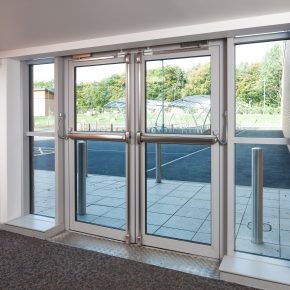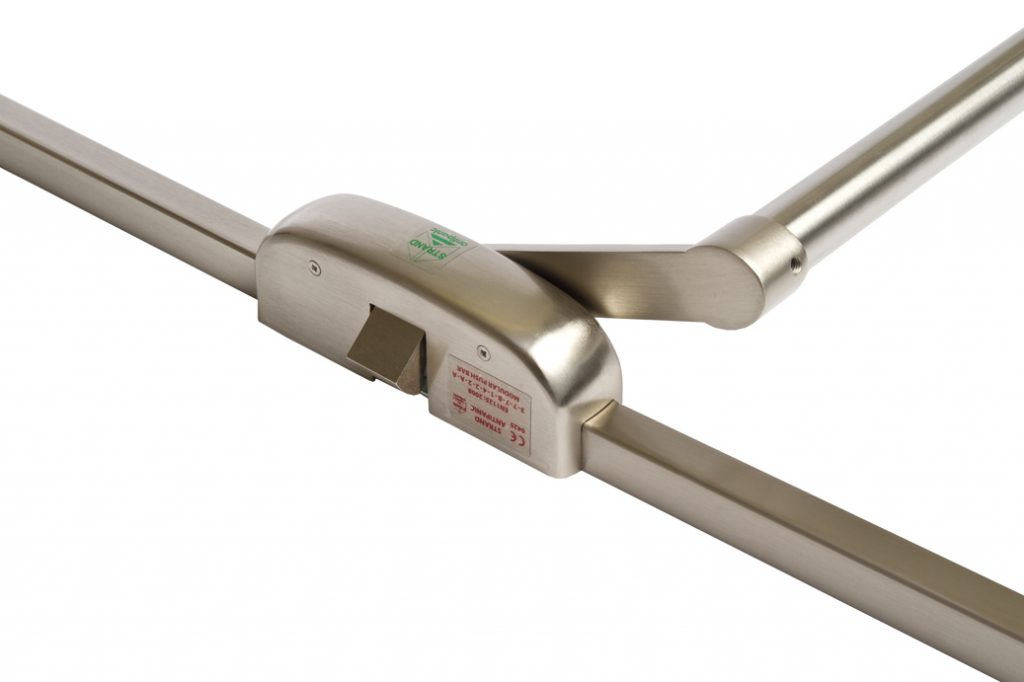
Strand Hardware: Barring All Eventualities
 When it comes to specifying hardware for emergency exit and panic doors, it’s important to consider where it is to be placed, who is likely to use it and in what circumstances. Strand Hardware’s Sales Director Craig Fox looks at considerations to hone down your choice…
When it comes to specifying hardware for emergency exit and panic doors, it’s important to consider where it is to be placed, who is likely to use it and in what circumstances. Strand Hardware’s Sales Director Craig Fox looks at considerations to hone down your choice…
“There are a variety of manual and electrical options available for escape door hardware but as with all products, its essential to consider the end user and the environment in which devices are to be placed. The primary purpose of any door on an escape route is for it be readily openable, and the type of premises and its level of occupancy will define whether what type of panic or emergency exit hardware to use.
The Code of Practice: Hardware for Fire and Escape Doors, published by the Door Hardware Federation (DHF) and the Guild of Architectural Ironmongery (GAI) defines the two:
– Panic exit devices to BS EN 1125: These devices are intended primarily for buildings where the public is likely to be present and a panic situation could arise if the building must be evacuated quickly. For this reason, the devices are designed to operate by body pressure alone and require no knowledge of their operation to enable safe and effective evacuation of a building.
– Emergency exit devices to BS EN 179: These devices are intended for escape from buildings where the public is unlikely to be present, and where the staff have been trained in emergency procedures and in the use of the specific emergency exit devices fitted. For this reason, panic situations are considered unlikely, and these devices are therefore permitted to have higher operating forces and do not need to release by body pressure alone.
In most cases a mechanical panic device will be the first choice. However, it’s worth considering if the door is to be used for other access requirements and whether users might have accessibility issues. For example, in a hospital or care home, motorised touch bars could provide additional functionality and ease-of-use.
Safety and security
Safety and security will also be a factor. All panic and emergency exit devices provide a level of security against intrusion, but where there is a need for increased security, additional measures can be taken to enhance it without compromising the ability of people to escape during an emergency.

It is essential to liaise with local building and fire authorities to determine building occupancy and undertake risk assessment if such measures are deemed necessary. These can include audible alarms, door monitoring devices and CCTV.
Motorised devices are often used on escape doors which require external access control to restrict who enters a building such as an entrance to a school or college. They are also suitable for use on automatic doors.

Motorised touch bars also provide convenience and enable efficient building management. They can be linked to a variety of access control systems which use swipe card, digital keypad or proximity reader to allow controlled access from outside. They are ideal for large commercial or public buildings and with the addition of a microswitch they can be linked into an estate management off-site control to provide door monitoring.”
Visit Supplier's page
Latest news

26th July 2024
Enfield Speciality Doors completes world-class project for Atlas Copco HQ
A rundown office and warehouse building completely transformed into a modern headquarters for Atlas Copco has been fitted with more than 120 internal fire doors from Enfield Speciality Doors.
Posted in Access Control & Door Entry Systems, Articles, Building Industry News, Building Products & Structures, Building Systems, Case Studies, Doors, Interior Design & Construction, Interiors, Posts, Restoration & Refurbishment, Retrofit & Renovation, Security and Fire Protection, Sustainability & Energy Efficiency, Timber Buildings and Timber Products, Wooden products
26th July 2024
Abloy UK launches new white paper
Abloy UK, a leading provider of security and access control solutions, has launched a new white paper.
Posted in Access Control & Door Entry Systems, Architectural Ironmongery, Articles, Building Industry News, Building Products & Structures, Building Services, Doors, Facility Management & Building Services, Health & Safety, Information Technology, Innovations & New Products, Publications, Research & Materials Testing, Security and Fire Protection
26th July 2024
MCRMA Member Profile: David Roy, Director of Roofconsult
David Roy of MCRMA member company Roofconsult has more than 50 years’ experience to draw upon working in the building envelope sector and a unique perspective on how it has changed in that time.
Posted in Articles, BIM, Infrastructure & CAD Software, Building Associations & Institutes, Building Industry News, Building Products & Structures, Building Services, Building Systems, Cladding, Information Technology, Restoration & Refurbishment, Retrofit & Renovation, Roofs, Walls
26th July 2024
Strand: Enhancing Door Functionality and Safety
Craig Fox, Sales Director for Strand Hardware, outlines how door industry professionals might apply door limiting stays…
Posted in Architectural Ironmongery, Articles, Building Industry News, Building Products & Structures, Building Services, Doors, Facility Management & Building Services, Health & Safety, Restoration & Refurbishment, Retrofit & Renovation
 Sign up:
Sign up: